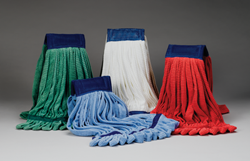Calculating return on investment with microfiber mopping systems.
By BJ Mandelstam Twenty years after microfiber’s debut and success throughout Europe, the United States is still slowly embracing microfiber technology. Often, it’s a product that is misunderstood, underutilized and considered too expensive. Despite these perceptions, studies have shown that microfiber is a cost-effective cleaning tool that can reduce labor hours or dollars from the bottom line, increasing employee productivity.
Twenty years after microfiber’s debut and success throughout Europe, the United States is still slowly embracing microfiber technology. Often, it’s a product that is misunderstood, underutilized and considered too expensive. Despite these perceptions, studies have shown that microfiber is a cost-effective cleaning tool that can reduce labor hours or dollars from the bottom line, increasing employee productivity.
As demand has grown for microfiber mops and cloths, manufacturers have created products that are more effective, easier to use and more affordable. There are many new factors to consider when calculating the true return on investment (ROI). A properly implemented microfiber-based cleaning program can streamline cleaning tasks, improve cleanliness, while reducing water and chemical usage. It’s also a cost-avoidance program — microfiber minimizes product replacement, and if used properly, helps preserve interior finishes, saving thousands of dollars and labor-hours in restoration.
Rapid returns
Many microfiber mopping and dusting systems are designed with the user in mind. The systems significantly reduce heavy lifting and awkward twisting associated with wringing and using a wet string mop. This is primarily due to eliminating the need for repeated fillings, lifting, moving and dumping of mop buckets. When using ergonomic tools, workers dramatically reduce the risk for repetitive stress injuries such as back strain which cost millions of dollars in workers’ compensation claims every year. At the same time, the lightweight microfiber mops are also ergonomically designed to maximize custodial productivity.
An evaluation conducted by Integrated Facility Services found that switching to lightweight microfiber flat mops increased custodial productivity by 18 percent. At Integrated, cleaning times were reduced because the lighter weight microfiber flat mop was faster to maneuver than a cotton string mop.
An important factor that is rarely considered when calculating ROI is microfiber’s intrinsic value. Introducing a new cleaning tool, such as microfiber, can impact the perception of the facility’s occupants and the building service contractor’s employees. The move can also result in harder-to-quantify returns such as improved custodial staff morale.
However, a BSC can prove that microfiber improves health, hygiene and indoor air quality by conducting ATP measurements on surfaces within the facility. Areas properly cleaned with microfiber should show an improvement over areas cleaned with traditional tools. Such data can serve provide a competitive advantage, too.
Incorporating microfiber products into a cleaning system can offer a rapid return on investment when every factor is quantified. Custodial services can comprise nearly a third of a facility’s expenses. Improvements in terms of increased labor efficiencies, reduced employee injury, improved cleanliness, reuse capabilities, and reduced water and chemical consumption, all impact the bottom line. The cumulative value of all these factors is what counts.
Industries such as healthcare, where microfiber has been embraced, have already captured the financial and health benefits, plus the cleaning efficiencies. It is time for building service contractors to re-evaluate the factors that impact their investment in microfiber.
BJ Mandelstam is the founder and president of Cleaning Matters, a Denver-based custodial consulting practice. Previously, she was the owner of an award-winning contract cleaning company. For more information, visit www.onlycleaningmatters.com.

